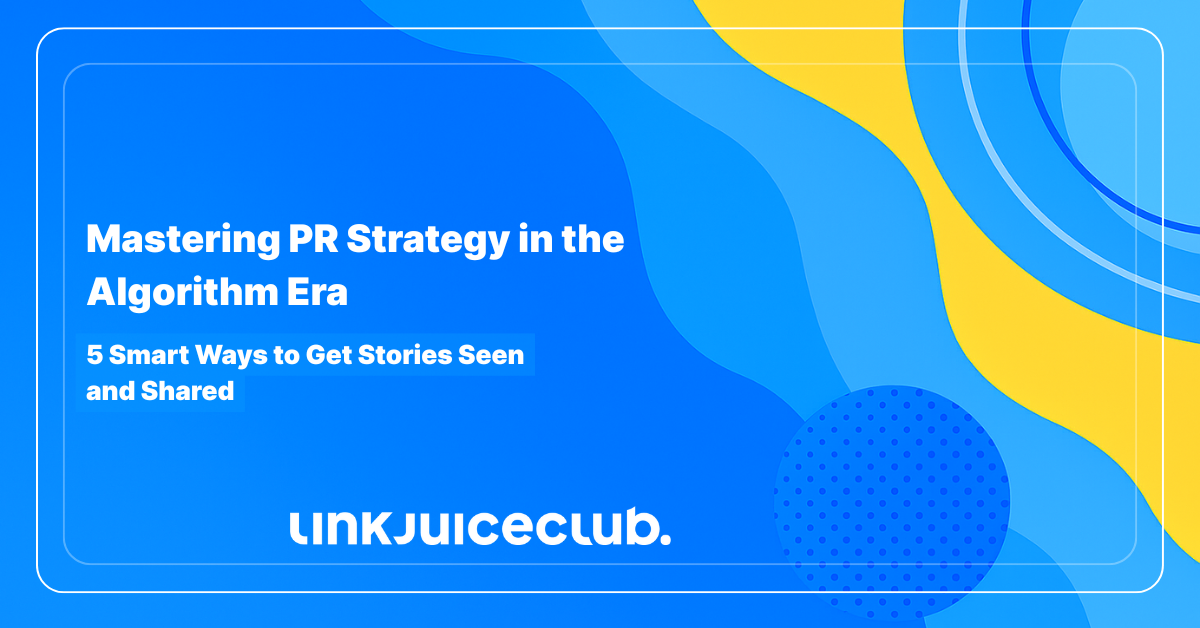
Mastering PR Strategy in the Algorithm Era: 5 Smart Ways to Get Stories Seen and Shared
In the world of algorithms and ever-scrolling feeds, a winning PR strategy isn’t just about getting coverage — it’s about being unforgettable.
To cut through the noise, you need more than press releases and cold pitches. You need content that speaks to journalists and search engines that are crafted with precision, purpose, and a pulse on what actually drives clicks and credibility.

Digital PR Meets SEO: A Crowded Arena With Sharper Stakes
Once upon a backlink, digital PR was a fresh hack in the SEO playbook — a clever way to score coverage and authority. But that golden window? It’s closing fast.
Now, PR strategy lives in a saturated space. Journalists have seen it all — recycled campaigns, templated emails, and pitches that scream “link grab” louder than value.
🧩 Here’s what’s changed:
- Journalists now know the SEO game — and they’re not here for lazy outreach.
- Creative ideas alone aren’t enough; execution and relevance are everything.
- More publishers are charging for coverage, squeezing out opportunities for organic wins.
🎯 So what actually works?
To earn attention (and links), your PR strategy needs:
- Hyper-relevant hooks tailored to a journalist’s beat
- Timely insights that match the current media mood
- Campaigns that balance newsworthiness with SEO value
Cut the fluff. Bring the substance. And always pitch with purpose.
1. Tune In to Journalists: Build Campaigns With Empathy, Not Just Angles
Behind every byline is a busy journalist juggling deadlines, inbox chaos, and editorial pressures. A strong PR strategy starts by understanding them, not just pushing what you want out there.
📌 What actually resonates?
- Timing, clarity, and relevance — not just seasonal trends, but why now matters
- Short, sharp hooks that align with a publication’s tone and audience
- Thoughtful storytelling — not self-serving pitches masquerading as news
🧠 Think like an editor:
- Customize your pitch summaries to match the outlet’s style
- Offer pre-made assets that ease the publishing process
- Skip the fluff and highlight what’s truly newsworthy
💡 Example pivot: Instead of vague “holiday shopping data,” spotlight eco-conscious gift trends for readers focused on sustainability. That’s how you move from general noise to specific value.
💥 Real Differentiation Tip:
Respect their time. Make their job easier. That alone sets you apart.
Want stronger, more sustainable media relationships?
- Target journalists by beat and outlet — not just domain authority
- Avoid transactional thinking, especially with outlets leaning toward paid coverage
- Stay curious about what they need, not just what you want to rank
2. Personalization That Lands: Be Human, Not a Headline Hunter
The difference between a pitch that lands and one that tanks? A little thing called intent.
In today’s hyper-aware media landscape, smart PR strategy means ditching fake familiarity and leaning into genuine connection. 🎯
💡 Real talk:
- Journalists know when you’re faking it — especially if you copy-paste praise or misuse their name like a cold email bot
- “Loved your piece on X” means nothing if it’s not specific, timely, or sincere
Here’s how to personalize with purpose:
- 🎯 Do your homework: Know the journalist’s beat, their voice, and what their audience actually cares about
- 📬 Tailor the pitch to their style — short, skimmable, and story-first
- 🧠 Be personable: Authenticity trumps over-the-top flattery every time
✅ Better yet, think beyond the pitch.
Strong PR strategy isn’t just about coverage — it’s about strategic partnerships. That starts by treating journalists like collaborators, not targets.
🤝 Build trust over time:
- Offer exclusive angles or early access to data
- Highlight shared goals: visibility, relevance, and real impact
- Respect their editorial instincts — and let them steer the narrative when needed
Personalization isn’t about being clever. It’s about being considerate. And that’s how you build relationships that last longer than a single campaign.
3. Build Campaigns That Rank — Not Just Link
Links are nice. But links that rank? That’s where your PR strategy really starts to pay off.
Too often, brands chase viral gimmicks — puzzles, contests, “dream job” stunts — just to earn backlinks. But if the coverage doesn’t rank or resonate with your actual audience, what’s the point?
📉 Here’s the trap:
- Big media sites can dominate SERPs — even with loosely related content
- But if that content isn’t relevant to your niche, it won’t send the right kind of traffic
- And if it doesn’t rank at all, it’s just a vanity win
Shift the Goal
Create campaigns that aren’t just linkable — they’re rankable. Anchor your PR strategy in topics your audience is already searching for, not random buzzbait.
Let’s say you’re working with a fintech brand.
Instead of launching a quirky “dream job to get paid for watching stocks” contest (which gets links but zero targeted traffic), you launch a campaign around:
- “The Cost of Credit Around the World” — backed by proprietary research
- Visualized in a clean, interactive tool
- With tailored angles for personal finance, consumer rights, and international news desks
This gives journalists substance, ranks for long-tail finance terms, and builds topical relevance and authority.
✅ Smarter campaigns mean:
- More qualified traffic
- Better engagement metrics
- Long-term brand equity (not just a spike in Ahrefs)
Don’t just fish for links. Build topical authority. Let your PR strategy fuel SEO momentum that actually moves the needle.
4. Go Beyond Backlinks: Track the Metrics That Actually Matter
A next-level PR strategy doesn’t stop at link counts. It dives deeper — into rankings, traffic, and brand visibility.
If you’re only tracking backlinks, you’re missing the bigger picture. Some of the most valuable wins come from how and where your coverage lives online.
📊 Keep your eye on these metrics:
- 🔍 Page rankings for external coverage — are they climbing the SERPs?
- 🔗 Link placement — are they follow, no-follow, or embedded with branded anchors?
- 🚦 Traffic trends — what’s flowing to your site and the referring source?
- 📣 Social engagement — is your campaign getting shares, saves, or silence?
- 🌐 Overall visibility — are people finding and remembering your brand?
💣 Bonus Insight:
Sometimes, a no-follow link on a well-ranked page can outperform a do-follow link buried in a site no one visits.
Don’t Overlook Alternative Channels
Beyond big-name media, consider platforms that punch above their weight in niche visibility:
- Influencer newsletters and social posts
- Reddit threads and niche forums
- Thought-leading bloggers and YouTubers
Many of these sources have stayed strong through algorithm shakeups and drive real, trusted engagement.
✅ Remember:
- Coverage that ranks keeps giving long after the email pitch is forgotten
- Metrics show momentum — not just vanity
- Smart PR strategy tracks what converts, not just what gets published
Think of your PR campaigns like a portfolio. Don’t just collect links. Invest in assets that drive performance.
5. Craft Scroll-Stoppers: Campaigns That Demand Attention
In a sea of endless content, your PR strategy needs one goal above all: make them stop scrolling.
There’s no perfect format. But there is a formula — campaigns that stir emotion, spark curiosity, or ride the wave of something timely. That’s what gets picked up, shared, and remembered.
🎯 High-performing campaign elements:
- 📊 Original data that aligns with seasonal trends or breaking stories
- 💬 Emotional narratives — joy, outrage, surprise — anything that makes people feel
- 🖼️ Visual assets like infographics, custom images, and embedded media that earn easy embeds and backlinks
- 🧠 Interactive content — quizzes, calculators, or tools that drive engagement and traffic
- 🌟 Influencer partnerships or expert interviews that bring built-in authority (and reach)
Make every campaign multi-dimensional — more than just a stat, story, or quote. Give journalists something rich to work with.
🧭 Stay ahead of the curve:
- Track trending topics across your industry and media landscape
- Align your PR strategy with newsroom cycles and audience moods
- Be fast — real-time relevance wins more than polished perfection
Your mission? Design campaigns that deliver value at every layer — clickable for the public, useful for journalists, and strategic for your brand.
When it clicks, it sticks. And that’s how PR earns its place in the algorithm age.
Key Takeaways: Making Your PR Strategy Work With the Algorithm — Not Against It
Digital PR in the algorithm era isn’t just about getting mentions. It’s about building resonance — with journalists, with audiences, and with search engines.
Here’s how to make your PR strategy count:
- ✅ Think like a journalist: Respect editorial time, craft pitches with purpose, and match your angle to their beat.
- ✅ Be real, not robotic: Personalization should feel human — not like a CRM gone wild.
- ✅ Prioritize rankable content: Chase topical relevance, not gimmicky links that disappear in a day.
- ✅ Measure what matters: Beyond backlinks, focus on rankings, traffic, and actual visibility.
- ✅ Create for impact: Develop campaigns that stop the scroll and deliver value from first glance to final link.
This isn’t about reinventing PR — it’s about refining it for a smarter, faster, algorithm-aware world. When your strategy is aligned, your stories don’t just get seen — they get remembered.





